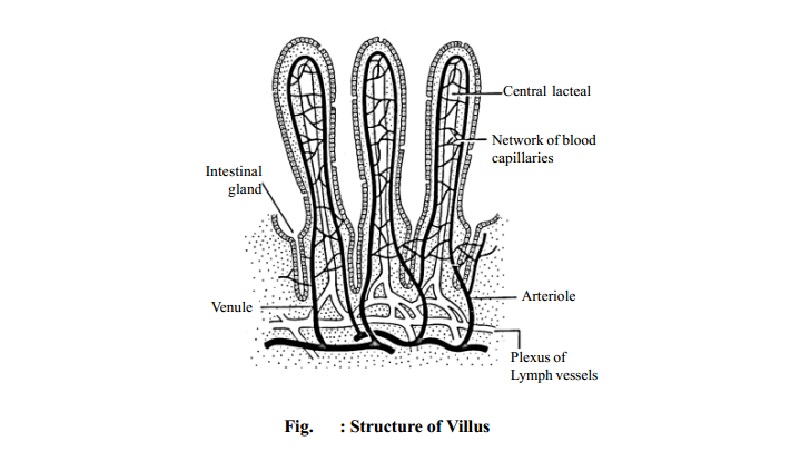Chapter: 11th 12th std standard Home Science Maintain Basic Knowledge for family life Higher secondary school College
Chemical digestion in the small Intestine and Absorption of Food

Chemical digestion in the small Intestine
When acid
chyme passes into the small intestine, it is mixed with pancreatic juice, bile
and intestinal juice.
Bile is not primarily a digestive juice because it contains no enzyme
but it helps in the digestion of fats. The bile salts emulsifies fats and helps
the pancreatic lipase to act and digest it easily. The pancreatic juice
contains 3 powerful enzymes. They are:
Pancreatic amylase - Converts carbohydrates - amylase into simple sugars
like glucose, fructose and galactose.
Trypsin & Chymotrypsin - Converts peptones into Polypeptides. In the
beginning trypsin is present in the form of inactive trypsinogen and
Chymotrypsinogen. This trypsinogen is converted into active trypsin by the
action of enterokinase which is secreted in the small intestine.
Pancreatic lipase - Converts fats into fattyacids and glycerol.
After pancreatic digestion, the food which is now called chyme proceeds
further in the intestine. Here it comes in contact with Succus entericus which
is a juice produced by the small intestine. Succus entericus contains three
enzymes. They are:
1. Erepsin - It converts polypeptides into amino acids.
Nucleotidases - Converts
nucleotide, into nucleosides.
Nucleosidases - Converts nucleosides into pentose, purine
and pyrimidine.
It also contains three sugar splitting enzymes called lactase, maltase
and sucrase converting the respective sugars into simple sugars, mostly
glucose. It also has lipase which acts on fats and converts them into fatty
acids and glycerol.
The final products of digestion of the carbohydrates is glucose, for the
proteins are amino acids and fats are fatty acids, and glycerol.
Absorption of Food
Absorption is the process by which water, minerals, vitamins and end
products of digestion are absorbed through the mucosa of alimentary canal
(especially the small intestines) into blood stream either directly or via
lymphatic vessels.
In the
stomach there is little absorption. Water, alcohol, glucose, and simple salts
are absorbed to a certain degree. The main absorption occurs in small intestine
especially in the lower (ileum) part, the upper part of the small intestine is
mainly associated with the process of digestion.
The mucous membrane of small intestine is covered with minute fingerlike
projections known as villi. About 50
lakhs of villi are found in small intestine. Each villus contains an arteriole, a venule, a capillary network and a
lacteal (lymphatic vessel). Nutrients that diffuse through the epithelial cells
which cover the villus are able to pass through the capillary walls and the
lacteal and enters the blood.
About 90%
of all absorption takes place throughout the length of the small intestine. The
other 10% occurs in the stomach and large intestine. Both monosaccharides and
amino acids are absorbed by a positive pressure gradient between the intestinal
content and the blood as well as by an active process involving enzymatic
reactions and transported in the blood stream to the liver via the hepatic
portal system. The excess amount of glucose is converted into glycogen and
stored in the liver, when need arises glycogen is converted into glucose and is
utilized by the body.
Fatty
acids and glycerol do not enter the blood stream immediately. They are absorbed
by the lacteals. So these lymph ducts are seen as white and milky in appearance
after a meal of fat. The mineral salts and water soluble vitamin B Complex and
C are absorbed via portal blood.
Functions of the Large Intestine
In the large intestine the absorption of water continues until semisolid
consistency of faeces is achieved. Mineral salts, vitamins and some drugs are
also absorbed into the blood capillaries from the large intestine. The large
intestine is heavily colonized by certain types of bacteria which synthesize
vitamin K and Folic acid. Unabsorbed carbohydrate undergoes bacterial
fermentation and produces gas. These gases pass out of the bowel as flatus. The
large intestine exhibits mass movements.
Defaecation
This is
the process of emptying the bowels or the passage of faeces. When a mass
movement forces the contents of the sigmoid colon into the rectum the nerve
endings in the anal walls are stimulated resulting in defaecation.
Related Topics